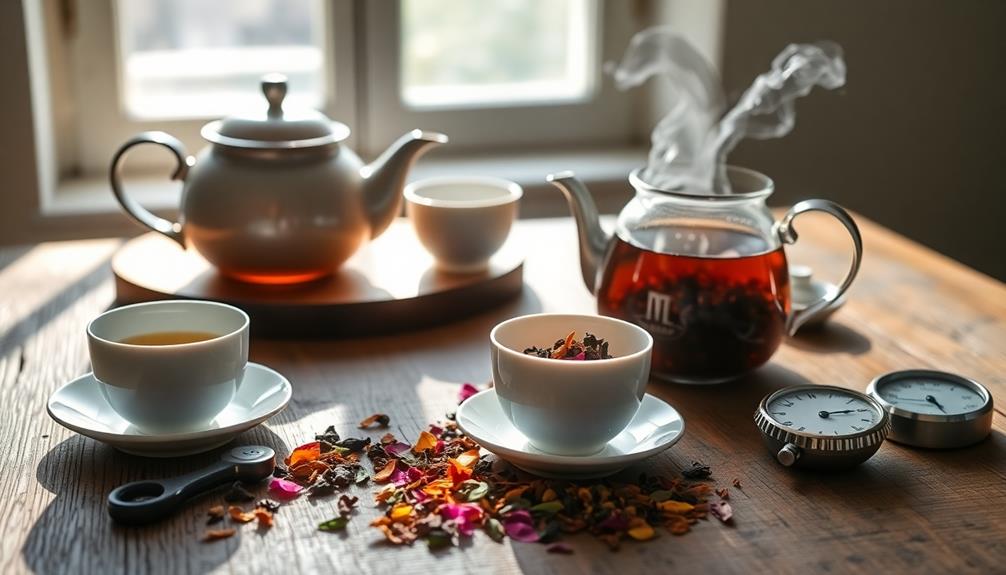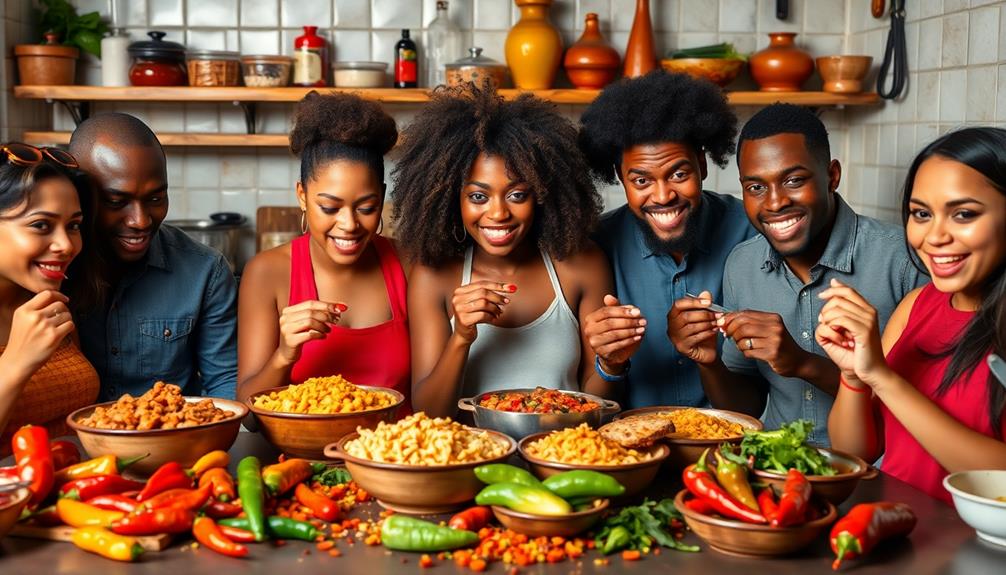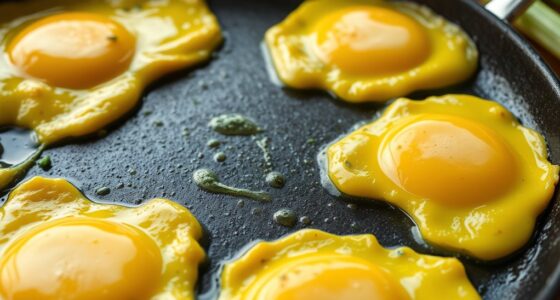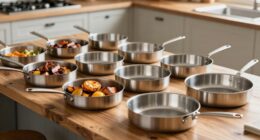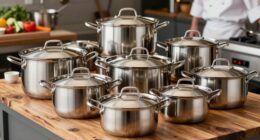To brew the perfect cup of tea, you need to take into account several scientific factors that affect flavor and enjoyment. Start with the type of tea; each variety—white, green, oolong, black, or Pu-erh—has unique processing methods that influence its taste. Water quality matters too; using soft or filtered water enhances flavor while preventing scum. Pay attention to brewing temperature and time—black teas need boiling water, while green teas need cooler temps. Finally, loose leaf tea generally offers richer flavors compared to teabags. If you want to elevate your tea experience, there's much more to explore about these elements and techniques.
Key Takeaways
- Water temperature significantly affects flavor extraction; black tea requires boiling water, while green tea needs lower temperatures for optimal taste.
- Brewing time is crucial; steep black and oolong teas for 4-5 minutes, and green tea for 2-3 minutes to avoid bitterness.
- Using loose leaf tea allows for better flavor diffusion compared to teabags, enhancing the overall tea experience.
- Soft or filtered water improves flavor and prevents tea scum, ensuring a visually appealing and tasty cup of tea.
- Freshness and quality of tea leaves are essential; higher quality loose leaf tea yields a richer flavor profile compared to lower-grade teabags.
Origins of Tea
Tea, a beloved beverage enjoyed worldwide, traces its origins to the leaves of the Camellia sinensis plant. This remarkable tea plant has two primary varieties: Camellia sinensis var. sinensis, commonly associated with China, and var. assamica, which hails from India.
Cultivating this plant dates back thousands of years, with its wild ancestors now extinct, underscoring its long-standing significance in human history. In many Chinese households, tea isn't just a drink but a crucial part of the cultural fabric, often enjoyed alongside dishes like Red-Braised Pork Belly, enhancing the dining experience.
Historically, tea's cultural significance is profound. It's been consumed for medicinal purposes for at least 60,000 years, illustrating how deeply ingrained it's in various societies. Throughout the ages, people have experimented with different processing methods, leading to the development of five main categories: white, green, oolong, black, and Pu-erh tea.
Each type offers distinctive flavors and experiences, shaped by the unique characteristics of the Camellia sinensis leaves.
You'll discover that the chemical compounds in tea, such as catechins and caffeine, not only contribute to its rich flavor profile but also enhance its potential health benefits.
Understanding the origins of tea helps you appreciate its role in culture and society, making every sip a connection to history.
Processing Techniques
Understanding processing techniques is essential for appreciating the diverse flavors and characteristics of tea. The way tea leaves are processed determines the final product you enjoy in your cup.
For instance, just as the unique preparation of Indonesian desserts like Kue Putu enhances their flavors, the processing of tea leaves greatly impacts their taste and aroma.
Here's a quick overview of how different processing methods shape tea:
- Green Tea: Rapid heating through pan-firing or steaming inhibits oxidation, preserving the leaves' green color and natural compounds, giving it a fresh, grassy flavor.
- Black Tea: This tea undergoes withering, rolling, and full oxidation. The leaves develop rich flavors and dark hues, resulting in a stronger taste profile that many tea enthusiasts love.
- Oolong Tea: Partially oxidized, oolong features both withering and rolling techniques. This unique processing creates a flavor that lies between green and black tea, offering a complex taste experience.
- Orthodox vs. Non-Orthodox: Orthodox methods maintain larger leaf structures for better flavor extraction, while non-orthodox (CTC) techniques produce smaller pellets that infuse quickly, ideal for teabags.
These processing techniques are vital in defining the distinct flavors and types of tea you can explore. Understanding them enhances your tea experience and appreciation.
Brewing Essentials
The journey to a perfect cup of tea continues with brewing, where the right techniques can elevate your experience. To truly enjoy your tea, focus on the brewing time and temperature. For black and oolong teas, steep for 4-5 minutes at temperatures between 98-100°C. Green tea, on the other hand, should be brewed for 2-3 minutes at around 80°C to keep its delicate flavors intact.
Here's a quick reference to help you:
| Tea Type | Brewing Time & Temperature |
|---|---|
| Black/Oolong | 4-5 minutes at 98-100°C |
| Green | 2-3 minutes at 80°C |
| Tea-to-Water Ratio | 1 teaspoon of loose leaf tea per 200 mL water |
Don't forget to pre-heat your teapot or mug with hot water before brewing. This simple step helps maintain the ideal brewing temperature and enhances the infusion process. Finally, always use soft or filtered water to avoid tea scum, ensuring your cup is visually appealing and flavorful. Happy brewing!
Water Quality Matters
Have you ever wondered why the taste of your tea can vary so much from cup to cup? One vital factor is water quality. Using the right water can make a significant difference in the flavor and overall experience of your brewing tea.
Additionally, just like selecting the freshest ingredients for dishes such as Nettle and Potato Soup, the quality of your water can enhance the nuances of your tea.
Here are four key points to reflect on:
- Soft or Filtered Water: This type of water enhances flavor and prevents tea scum, which can negatively impact both taste and appearance.
- Hard Water Issues: High levels of calcium in hard water lead to unsightly tea scum, diminishing your tea's quality and enjoyment.
- Flavor Extraction: The composition of water greatly influences how well flavors and aromas are extracted from tea leaves, making quality water essential.
- Freshly Boiled Water: Always use freshly boiled water, as it maintains adequate oxygen levels, vital for flavor extraction during brewing.
If you live in an area with hard water, think about filtering it to improve your tea's quality.
Temperature and Timing
Water quality sets the stage for your tea's flavor, but the right temperature and timing can elevate your brewing experience even further. For instance, the delicate flavors found in Asian Cuisine can provide great inspiration for your tea pairings.
The temperature of the water plays a vital role in extracting the best flavors from your tea. For black tea, you'll need boiling water, around 98-100°C, while green tea requires lower brewing temperatures, around 80°C. Using the correct temperature prevents bitterness, especially in delicate teas.
Timing is just as important as temperature. Black and oolong teas typically require a brewing time of 4 to 5 minutes, allowing their rich flavors to unfold. On the other hand, green tea should steep for only 2 to 4 minutes to avoid excessive tannin extraction, which can lead to astringency.
Remember, over-steeping for more than 7 minutes can turn your perfect cup of tea into a bitter experience.
To enhance flavor extraction, consider pre-heating your teapot or mug. This small step helps maintain the best brewing temperature throughout the steeping process.
Loose Leaf vs. Teabags
When it comes to brewing tea, the choice between loose leaf and teabags can greatly impact flavor and quality.
Loose leaf tea allows for better movement and extraction, which is similar to how traditional dishes like Muamba De Galinha benefit from their key ingredients melding together for rich flavor.
On the other hand, teabags may limit that experience due to their compact design and smaller leaf pieces.
Understanding these differences helps you decide which method suits your taste preferences best.
Flavor Extraction Comparison
In the world of tea, the choice between loose leaf and teabags greatly impacts flavor extraction. If you're looking for that ideal flavor experience, understanding the differences can enhance your brewing process. Here's how loose leaves compare to teabags:
- Movement: Loose leaf tea allows for better movement in water, enhancing flavor diffusion, while teabags restrict movement. This is similar to how a well-prepared dish, like Graveyard Taco Dip, benefits from layers for enhanced flavor.
- Leaf Size: Teabags often contain smaller leaf pieces, limiting surface area and resulting in a less complex flavor profile.
- Space for Infusion: The space in loose leaf tea is essential for robust extraction, allowing more aromatic compounds and polyphenols to be released.
- Flavor Richness: Studies show that brewing with loose leaves can yield a richer, more nuanced flavor, retaining essential oils and aromas better than teabags.
While 96% of consumers choose teabags for convenience, those who prioritize taste often lean towards loose leaf tea, especially with black teas.
If you're aiming for a truly satisfying cup, opting for loose leaves can make a significant difference in flavor extraction and overall enjoyment.
Freshness and Quality
For tea lovers, freshness and quality are essential factors that can make or break your brewing experience. When you choose loose tea over teabags, you're likely opting for a richer flavor profile. Loose leaf tea consists of larger, whole leaves that allow for better flavor diffusion, while teabags often contain smaller, broken leaves. This limitation restricts the movement of the tea leaves, resulting in suboptimal flavor extraction.
Additionally, just as traditional Brazilian dishes like Caldeirada showcase the importance of fresh ingredients, using high-quality loose leaf tea can elevate your brewing experience.
The freshness of the tea leaves plays a significant role in determining the quality of your brew. Loose leaf tea is often fresher since it's less exposed to light and air, preserving its aromatic qualities. In contrast, many teabags use lower-grade leaves, which can lead to a bland cup lacking in depth and complexity.
Although larger tea bags can improve flavor extraction compared to standard teabags, they still fall short of the superior experience you get from loose tea.
Investing in high-quality loose leaf tea not only enhances the freshness and flavor of your brew but also enriches your overall tea experience. So the next time you're brewing a cup, consider the importance of freshness and quality in your choice.
Brewing Techniques Differences
Brewing tea can feel like an art form, and the differences between loose leaf and teabags are essential to mastering it. When you're brewing, understanding these differences can elevate your tea experience. Here's how they compare:
- Flavor: Loose leaf tea allows for better movement in water, enhancing flavor diffusion. Teabags, however, contain smaller leaf pieces that limit flavor complexity. For example, the rich flavors found in dishes like Mushroom Masala can be likened to the depth of flavor that loose leaf tea provides.
- Brewing Time: Loose leaf tea typically requires longer steeping times (2 to 8 minutes) to extract over 30,000 flavor compounds. Teabags can lead to under-extraction if steeped for less time.
- Quality: The chemical composition of loose leaf tea is generally higher quality, as larger leaves release essential oils and antioxidants more effectively. Teabags often contain fragmented leaves, sacrificing quality.
- Infusion Space: Using a larger infuser for loose leaf tea maximizes space, promoting better extraction of flavors and aromas compared to the confined space of teabags.
The Role of Caffeine
Caffeine plays a significant role in the world of tea, influencing both its flavor and invigorating effects. When you sip a cup of black tea, you're likely experiencing higher caffeine levels, ranging from 40 to 70 mg per 8 oz cup. In contrast, green tea offers a milder experience, with about 20 to 45 mg of caffeine. This difference not only affects how energized you feel but also the overall taste of your perfect cuppa.
Notably, much like the rich flavors found in a Cobb Salad, the balance of caffeine can enhance the complexity of tea flavors.
Caffeine acts as a natural pesticide and herbicide in tea plants, contributing to its bitter flavor that can deter pests. When brewing, you might consider the initial steeping method. If you steep for 30 seconds and discard the water, you can lower the caffeine content. However, this can lead to a flatter flavor profile because you're removing caffeine's bitter compounds, which add depth to your tea.
Understanding your sensitivity to caffeine is essential, as it can enhance alertness and cognitive function differently for each person. By finding the right balance between caffeine content and flavor, you can enjoy your favorite brews without feeling overly stimulated.
Adding Milk: Best Practices
When it comes to adding milk to your tea, the technique you choose can really impact the flavor.
Just like the delicate balance found in traditional Japanese confections such as Dorayaki (Red Bean Pancake), adding milk at the right moment helps preserve its texture and taste.
Let's explore the best practices for balancing these elements to create your perfect cup.
Milk Addition Techniques
The order in which you add milk to your tea can greatly impact its flavor and overall experience. When brewing black tea, the right technique guarantees you enjoy your cup to the fullest. Here are some best practices for adding milk:
- Add Milk Last: If you're brewing directly in a cup, pour in the milk after the tea. This preserves the aromatic qualities and balances the flavors.
- Consider Brewing Method: If you're using a teapot, adding milk first can help maintain ideal brewing conditions, as it prevents the tea from cooling too quickly.
- Control Temperature: High temperatures can cause milk proteins to denature, negatively affecting the taste. Be mindful of when you add your milk.
- Experiment: Don't hesitate to try different methods! Each approach can yield different flavor profiles, so find what works best for your palate.
Temperature Considerations
Controlling the temperature of your tea is vital for achieving the perfect balance of flavors, especially when adding milk. The method you choose to brew your tea influences how and when to incorporate milk. Here's a quick comparison of best practices:
| Method | Milk Addition Recommendation |
|---|---|
| Teapot | Add milk first to manage brewing temp |
| Cup | Add milk last to maintain flavor |
When you brew in a teapot, adding milk first helps regulate the temperature, ensuring it blends well with the tea. However, if you're brewing directly in a cup, adding milk last preserves the intended flavor profile. It's important to remember that adding milk at high temperatures can degrade its proteins, negatively affecting the overall taste.
George Orwell advocated for adding milk last to control the quantity, while the Royal Society of Chemistry suggests the opposite for teapots. Ultimately, your approach should depend on your brewing method to achieve that perfect cup of tea. Choose wisely to enjoy the full spectrum of flavors in your brew!
Flavor Balancing Strategies
Balancing flavors in your tea can transform a simple cup into a delightful experience, especially when you're adding milk. The way you add milk can greatly influence the overall tea taste. Here are some best practices for flavor balancing when incorporating milk:
- Add Milk Last: If you're brewing directly in a cup, add milk after the tea has steeped. This gives you control over the quantity and helps maintain ideal flavor extraction.
- Check Milk Temperature: Always consider the temperature of the milk. High temperatures can degrade milk proteins, resulting in a less pleasing flavor. Ideally, use milk just below boiling.
- Use a Teapot?: When brewing in a teapot, you might want to add milk first. This guarantees a consistent blend and can prevent scalding, according to the Royal Society of Chemistry.
- Follow George Orwell's Advice: He suggested adding milk last for better control over infusion, enhancing the tea's overall taste, especially in stronger brews.
The Chemistry of Flavor
Flavor in tea is a complex tapestry woven from over 30,000 chemical compounds, each playing an essential role in crafting its unique profile. Among these, tannins and polyphenols stand out for their significant impact on flavor.
Tannins, released during brewing, can enrich the taste but risk bitterness if steeped too long. That's why it's vital to monitor your brewing time.
The balance of lighter polyphenols and caffeine dissolving at different rates during brewing also affects your tea's overall flavor complexity. When you adjust the brewing temperature, you influence the extraction of these compounds. Higher temperatures yield stronger flavors but may intensify the bitterness from tannins.
Don't forget about L-theanine, an amino acid in tea that enhances flavor while promoting a calming effect. This unique combination counteracts the stimulating effects of caffeine, creating a more balanced drinking experience.
Frequently Asked Questions
What Is the Science Behind Making the Best Tea?
To make the best tea, you need to take into account water quality, brewing temperature, steeping time, and loose leaf versus teabags. Each factor affects flavor and aroma, ensuring you enjoy a delicious, well-balanced cup every time.
What Is Scientifically Happening as You Make a Cup of Tea?
As you summon the magic of water and leaves, dance unfolds. Heat awakens hidden treasures, coaxing flavors and aromas from their slumber. Each steeping moment crafts a symphony, where balance creates the elixir in your cup.
How to Make the Perfect Cup of Tea Scientifically?
To make the perfect cup of tea, start with filtered water, choose the right temperature, steep for the appropriate time, maintain a proper tea-to-water ratio, and pre-warm your teapot for ideal flavor extraction.
How Does Tea Work Scientifically?
When you brew tea, it's like conducting an orchestra. Each temperature and time influences the harmony of flavors, releasing compounds that dance together, creating a symphony of taste, aroma, and health benefits just for you.
Conclusion
So, you might think making the perfect cup of tea is just a matter of boiling water and steeping a bag. But it's so much more! By understanding the origins, processing, and brewing techniques, you can truly elevate your tea experience. Don't settle for mediocre; embrace the science behind it. Experiment with different leaves, water quality, and temperatures to discover your ideal brew. Once you do, you'll appreciate tea like never before—it's not just a drink; it's an art!
